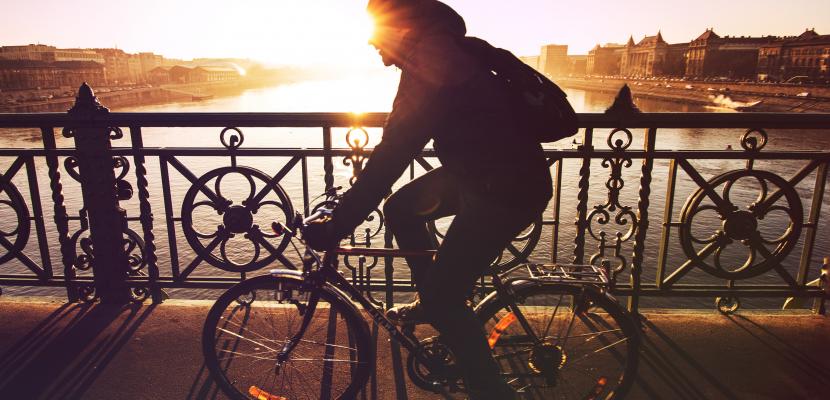Image

Europa-Radbahn
Published on 23 June 2021

Germany
Düsseldorf
This is the good practice's implementation level. It can be national, regional or local.
About this good practice
The Europa-Rahdbahn is an important addition to the cycling network in the region attracting different target groups (commuters, tourists, families, school kids, etc.) and is tailored to the region´s needs. It connects the cities of Kleve & Kranenburg with the Dutch city of Nijmegen.
Increasing the intermodal share of cycling is a key objectives of the city of Kleve and the municipality of Kranenburg. The modern route is suitable for all kinds of bicycles & cyclists but is especially well equipped for e-mobility. The cycling highway is ca. 23 km in total, starting in Kleve (DE) and ending in Nijmegen (NL), also crossing rural areas around the municipalities Kranenburg (DE) and Berg en Dal (NL). A special feature of the cycling highway is that cyclists are prioritized over motorised traffic, e.g. giving cyclists priority at traffic lights at junctions.
Along the route, there are rest areas with parking facilities, e-bike charging stations and several bicycle rentals.The lighting along the route is constructed to be minimally invasive the environment. It runs alongside the old train tracks on which currently a rail trolley is used for touristic means. A comprehensive communication concept was elaborated using continuous presswork, targeted brochures and explanatory films highlighting benefits and advantages of the new route for different target groups.
Increasing the intermodal share of cycling is a key objectives of the city of Kleve and the municipality of Kranenburg. The modern route is suitable for all kinds of bicycles & cyclists but is especially well equipped for e-mobility. The cycling highway is ca. 23 km in total, starting in Kleve (DE) and ending in Nijmegen (NL), also crossing rural areas around the municipalities Kranenburg (DE) and Berg en Dal (NL). A special feature of the cycling highway is that cyclists are prioritized over motorised traffic, e.g. giving cyclists priority at traffic lights at junctions.
Along the route, there are rest areas with parking facilities, e-bike charging stations and several bicycle rentals.The lighting along the route is constructed to be minimally invasive the environment. It runs alongside the old train tracks on which currently a rail trolley is used for touristic means. A comprehensive communication concept was elaborated using continuous presswork, targeted brochures and explanatory films highlighting benefits and advantages of the new route for different target groups.
Resources needed
Budget of total project: 6.52 million EUR
Funding by Federal government: 4.3 million EUR (ca. 70 %)
Funding by North Rhine-Westphalia: around 921,000 EUR
Funding by municipalities: 1.3 million EUR
Funding by Federal government: 4.3 million EUR (ca. 70 %)
Funding by North Rhine-Westphalia: around 921,000 EUR
Funding by municipalities: 1.3 million EUR
Evidence of success
- Increase of modal share of cycling in the municipalities involved.
- Frequently used by different target groups.
- The commitment to climate protection of the Europa Radbahn was recognised by the state of North Rhine-Westphalia, as “pioneers in the KlimaExpo.NRW showcase”.
- Frequently used by different target groups.
- The commitment to climate protection of the Europa Radbahn was recognised by the state of North Rhine-Westphalia, as “pioneers in the KlimaExpo.NRW showcase”.
Potential for learning or transfer
Wholesome approach focusing on a number of elements to increase modal share of bikes on this route:
- wide track for overtaking in both directions
- priority for cyclist at junctions when crossing streets ("green wave")
- sufficient lighting (in cities and at crossings), minimally invasive to the environment
- Cycling-friendly surface
- cross-border cycling highway with joint construction efforts to shorten construction time
- appeals to a lot of target groups; tailored comprehensive communication strategy for each target group
- wide track for overtaking in both directions
- priority for cyclist at junctions when crossing streets ("green wave")
- sufficient lighting (in cities and at crossings), minimally invasive to the environment
- Cycling-friendly surface
- cross-border cycling highway with joint construction efforts to shorten construction time
- appeals to a lot of target groups; tailored comprehensive communication strategy for each target group
Further information
Website
Good practice owner
You can contact the good practice owner below for more detailed information.
Organisation
City of Kleve

Germany
Düsseldorf
Contact
Project Coordinator